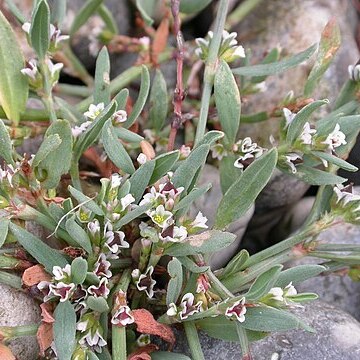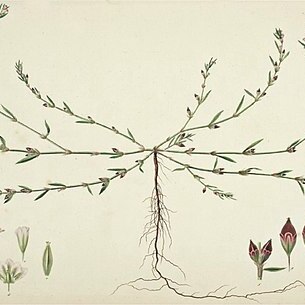Plants green to blue-green, homophyllous. Stems prostrate to ascending, branched at proximal and middle nodes, not wiry, 20-100 cm. Leaves: ocrea 6.5-12 mm, proximal part cylindric, pruinose, distal part hyaline, soon disintegrating into brown fibers or nearly completely deciduous; petiole 0-1 mm; blade green to bluish green, elliptic-lanceolate to linear, 10-35 × 1.5-15 mm, margins flat or narrowly revolute, apex acute; middle stem leaves slightly larger than adjacent branch leaves, distal leaves overtopping flowers. Inflorescences axillary, cymes uniformly distributed, 2-7-flowered. Pedicels exserted from ocreae, 2.5-5(-7) mm. Flowers semi-open; perianth 3.5-5.5 mm; tube 28-39% of perianth length; tepals slightly overlapping, green, margins white to pink, petaloid, not keeled, oblong to obovate, not cucullate; veins branched; stamens 8. Achenes exserted from perianth, pale brown to dark brown, ovate, 3-gonous, (3.5-)4.1-5.5(-6.5) mm, faces subequal, apex not beaked, edges straight, shiny, smooth or with fine tubercles especially toward apex; late-season achenes unknown.
More
Much like no. 5 [Polygonum glaucum Nutt.], often greener; ocreae to 5(–7) mm, brown, 3–7-nerved, lacerate; mature perianth 3–5 mm; achenes 3.5–5 mm (to 6.5 mm in late fls); 2n=40. Damp beaches; Atlantic coast from N.S. and N.B. to Nf., and in nw. Europe, perhaps only intr. in Amer. (P. acadiense; P. raii)


